1110 Search Results for Core
August 5, 2013
by Robin Parker -
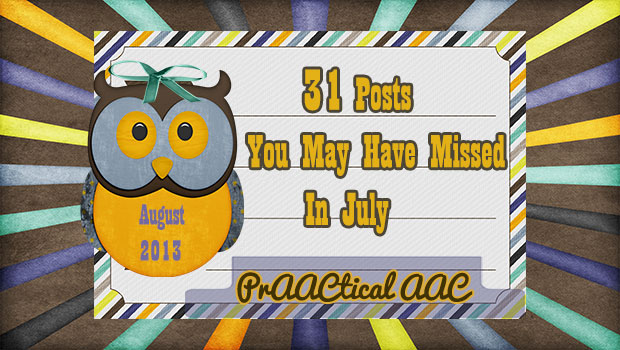
PrAACtical Thinking Free Text-based AAC Apps for the iPad PrAACtical Questions: Can Students Take Their AAC Device Home? PrAACtical AAC Learning & July 4th: Get Ready Get Set Go 4 Free July 4th Apps to SPARK Commenting 30 Posts You May Have Missed in June 4+AAC Tips for Talking About July 4th AFTER the Festivities PrAACtically Ready to Read Did You Know: AADMD Offers Specialty Webinars Visual Schedule Myths Live On..& On Getting to Yes Working with Worksheets Apps to Prepare, Learn, & Talk About Summer Vacations Modify a Battery-Operated Toy To Make It Accessible By Switches 5 Great Ways To Help People with AAC Needs Develop Inner Speech What’s the Connection: Core Vocabulary and Visual Schedules Random App of Kindness Giveaway: Talk About Food Create Your Own Style PECS Book 5 Things to Consider About Assigning ‘Homework’ to Your AAC Clients 8Friday Fun: 8 AAC Activities that are Fast... [Read More...]
August 2, 2013
by Robin Parker -
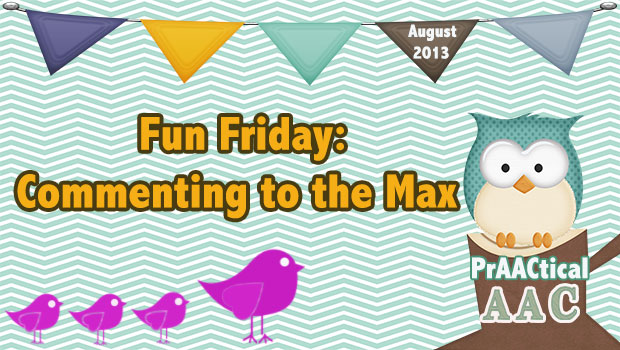
Commenting is for everyone, even if they are beginning communicators and even if they need to learn. If you are teaching commenting to a learner who does not yet have this communication function, there has to be ‘buy in’ or interest through another communication function that is already known. So, for a learner who can ask for things they want or say ‘no’ to things they ‘don’t want’, you may need to form routines where they ask for something, comment, then can ask (and receive) again. Once the routine is established, you can add some more teaching and language facilitation strategies. We have written about commenting before but when we saw this cool photo on Facebook, we just had to mention commenting again. Commenting to the Max Go Ape! 10 Commenting Communication Temptations More Ways to Teach Commenting Make it Meaningful to the Learner – Just talking about things may... [Read More...]
July 27, 2013
by Carole Zangari -
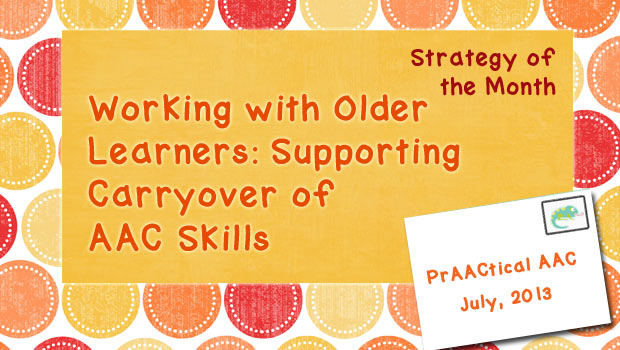
One of the biggest challenges that SLPs face is how to help the communicator use new skills outside the therapy room. Whether the client is someone who stutters, has voice problems, or any other speech-language difficulty, the question is the same: How can we get the client to use skills that were learned and practiced in a therapeutic situation to use those same skills at home, in school, and in the community? It’s an issue with all learners, but for adolescents and adults, we seem to be playing ‘catch up’ all the time. Plus, they are encountering greater numbers of less familiar communication partners and have to fend for themselves more often, making skill generalization even more of a critical topic. Much has been written about problems of generalization by using loose training, and varying the instructional setting, partners, instructions, prompts, and materials. In our way of thinking, it starts... [Read More...]
July 23, 2013
by Robin Parker -
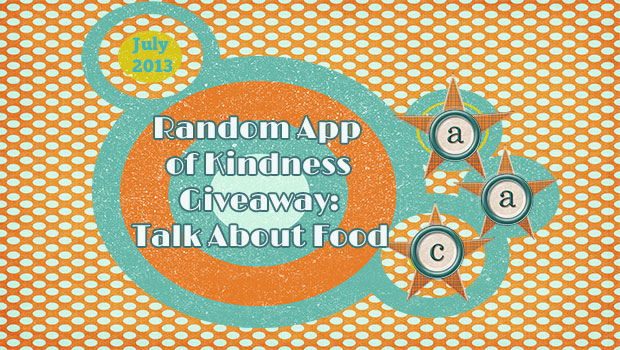
It’s a summer prAACtical Random App of Kindness giveaway! Thanks to the generosity of Hump Software (& Celeste Helling), we have 3 codes for Talk About Food. Talk about Food has been developed to target vocabulary building and communication skills. It has been designed specifically for children with low vision as well as those who are having difficulty with language development, or just starting to learn and use words through AAC. Pictures of food and food categories are high contrast to spark interest and visual attention. Then, the focus is talking about food (hence the app name). The communication emphasis is on core word vocabulary (Yay!) and building sentences. There are many great features & access settings and you can easily hide and show vocabulary for customization. The Giveaway starts now and ends on Saturday July 27th at 11:59 pm. We will select 3 winners for the Talk About Food App.... [Read More...]
July 18, 2013
by Carole Zangari -
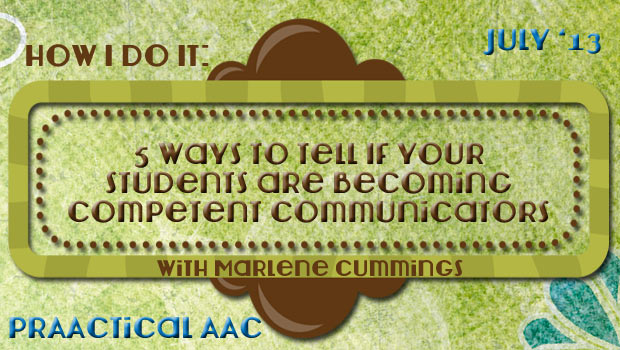
It’s always a good day when we get to share the thoughts of veteran AAC SLP, Marlene Cummings. In this post, Marlene talks about the signs to look for as clients gain skills with AAC and wraps up her series of posts on her yearlong experience in providing embedded professional learning experiences in Oakland Schools. You can see her earlier posts on cultivating the right mindset, their framework for AAC success, her AAC implementation toolbox, and the communication environment. 5 things in our “Destination Toolbox” “Are we there yet?” or “Five Ways to Tell That Your Students are Becoming Competent Communicators” Students are: Participating in the purposes of communication by novelly generating multiple word phrases demonstrating a variety of communicative functions Taking multiple communicative turns with multiple partners in multiple environments Using words from many different word classes Using words to talk about words Using language to communicate and communicating to learn... [Read More...]
July 9, 2013
by Robin Parker -
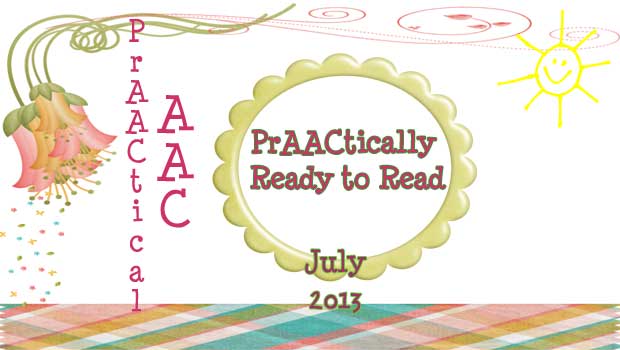
It’s summer and hot where we live (really hot!), humid (really humid)!. This weather makes it a good time for quiet, peaceful activities. Reading is high on our list. No pressure, enjoyable reading. We want ALL learners to enjoy reading. From simple single message voice output devices/apps to high-tech core language based SGDs and everywhere in between, there are lots of prAACtical opportunities for communication building, literacy learning, and just plain fun through reading. Interactive reading, reading aloud to someone, or reading to yourself can all be done in air-conditioned homes or libraries or by the pool or beach where you can cool down with a quick swim. Here are some great resources for adapted books, communication boards to go with books, and visual supports to help with reading. Find a good book, stay cool, and enjoy: New York City Department of Education: Adapted Books Baltimore City Schools- Book Specific Communication... [Read More...]
July 4, 2013
by Robin Parker -
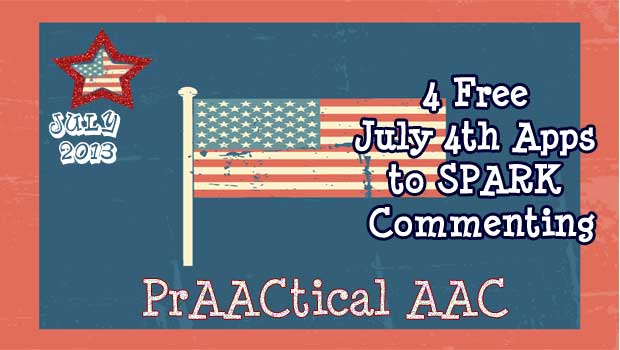
Check out these 4 free apps that can help SPARK commenting. They are great fun that will inspire commenting but can also help with core (and fringe) vocabulary as well as with being familiar with July 4th festivities. By engaging with these apps in an interactive manner, there is not the noise and confusion of the day. The apps become a good tool for familiarizing and preparing the learner for July 4th. Celebrate 4th of July, Independence Day of the United States , with sparkling fireworks (by Auryn Apps) Free – Just shake or touch the iPad and beautiful fireworks get triggered. The are really beautiful which are opportunities to comment again and again (“wow”, “beautiful”, “so cool”, “look colors”, etc.). Each firework reveals images that relate to Independence Day. This app is a gift from Auryn Apps which is a generous and dedicated developer for July 4th and throughout the year.... [Read More...]
June 28, 2013
by Carole Zangari -
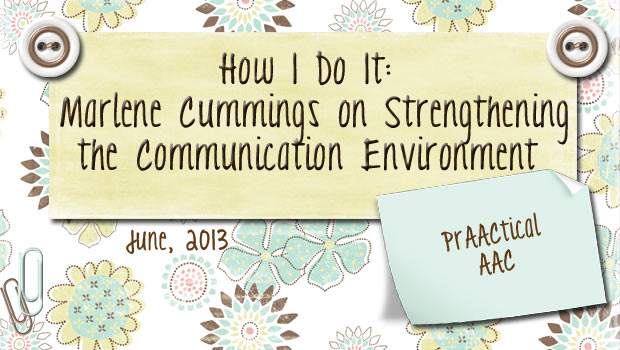
Marlene Cummings is back to share some thoughts on creating communication-friendly environments. As an AAC consultant to the Oakland Schools, Marlene gets to support AAC implementation in a variety of classrooms with all types of learners. You can read her earlier posts here and here. ::::::::::::::::::::::::::::::::::::::::::::::::::::::::::::::::::::::::::::::::::::::::::::::::::::::::::::::::::::::::::::::::::::::::::::::::::::::::: 5 Things to Consider in the “Communication Environment” The first thing we want to ask: Is language being represented visibly? We in AAC are often known by our “stuff”. Because we need to represent language visibly and love technology, we typically have a lot of “stuff”. I, for one, currently have a large storage unit holding 30+ years of “stuff” waiting to be distributed to all my new teams since I am no longer in the classroom. Let’s start by looking around our instructional environment. It is our intention to model the use of language being represented visibly and to provide the vocabulary and opportunities for... [Read More...]
June 20, 2013
by Carole Zangari -
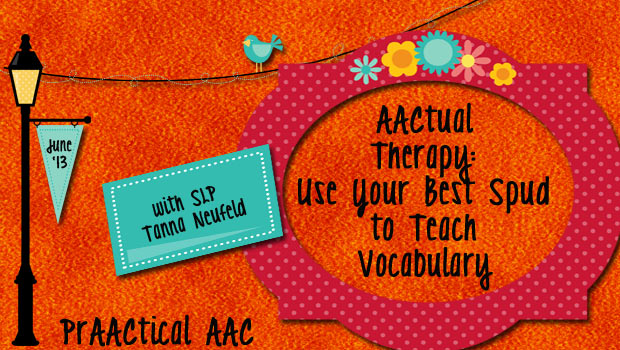
AACtual Therapist Tanna Neufeld comes through again, putting a prAACtical touch on an activity we all know and love. Tanna has generously shared both her ideas and the communication boards that she uses for this activity. You can download them in our eToolBox or go to the links at the end of this post. Tanna has great intervention tips (love her 80/20 idea!) that are prAACtical and effective for keeping kids engaged and learning. Mr. Potato Head is one of my favorite therapy tools for working with all kids, but especially beginning communicators. This awesome spud is not only a versatile toy-ripe for building, pretending, and interacting-but also a great tool for modeling vocabulary. For those little ones that you can keep engaged beyond the putting in and out of the building stage (tap into that good old fashioned, therapeutic use of self!), this toy really goes the distance. I... [Read More...]
June 13, 2013
by Carole Zangari -
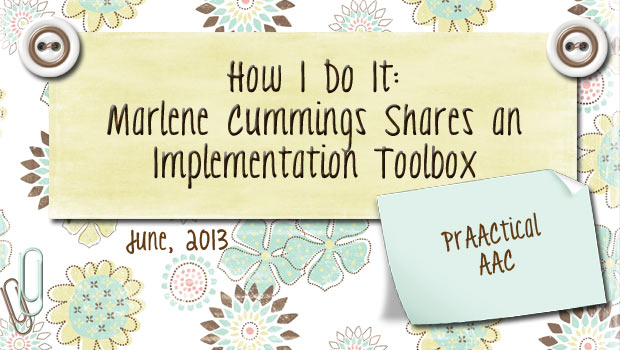
Now that the school year is winding down, some of you have a little more time to read, process, and prepare for next year. We are really excited to share more ideas from Marlene Cummings, one of the most experienced AAC SLPs that we know. Those of you who have been following Marlene’s posts on the AAC implementation will be pleased to see the next part of the Framework for Success that she developed with the AAC Team at Oakland School District. If you missed her first and second posts, go take a peek at them when you can. 5 Things in our “Implementation Toolbox” When we begin the process of implementing AAC it is important to consider our “thinking”. We always want to approach every student, every team and every classroom with as much wisdom and respect as possible. One of my colleagues, Dr. Penny Hatch, from UNC Chapel Hill... [Read More...]









